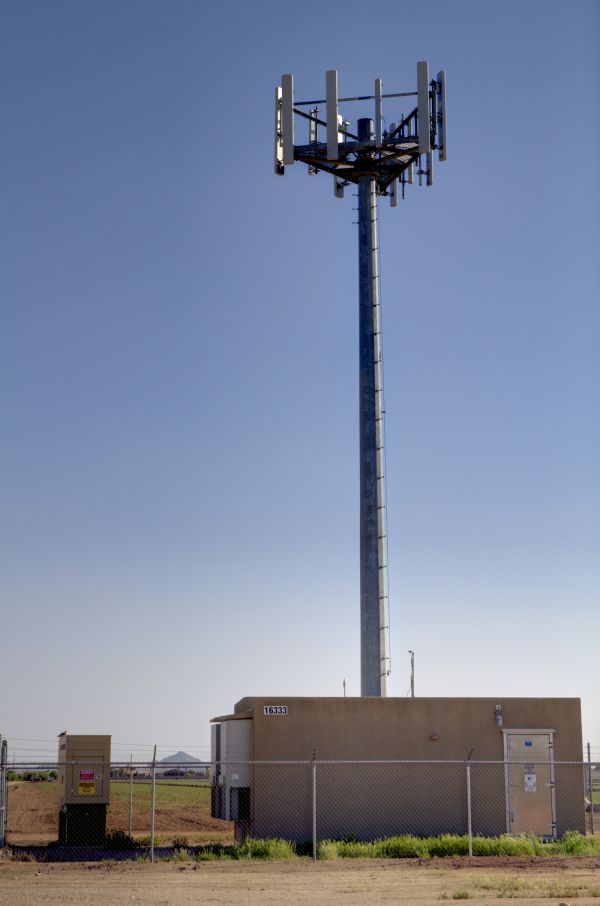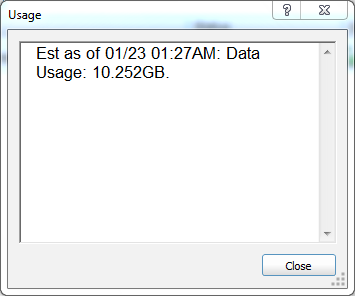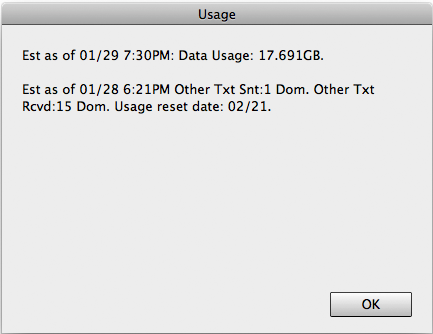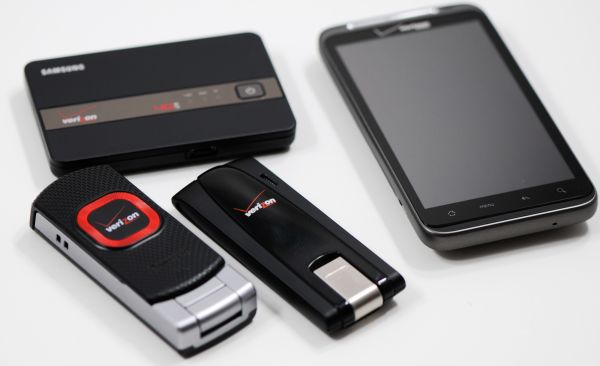Verizon 4G LTE: Two Datacards and a WiFi Hotspot Massively Reviewed
by Brian Klug on April 27, 2011 12:11 AM EST- Posted in
- Smartphones
- Samsung
- Verizon
- LTE
- 4G
- Pantech UML290
- USB551L
- Mobile
- MDM9600
Conclusion and Final Thoughts
We've been over a lot throughout the course of this review, but there's still so much more to be said about both LTE and the intricacies of Verizon's implementation. We're going to be doing a larger and more educational anthology piece later in the summer as well. Further, we'll no doubt give the same treatment to other carriers launching new LTE networks and faster HSPA+ ones.

A photo of a Verizon 4G LTE eNodeB in a field. Longer antennas on the tower are for 700MHz LTE.
The end result of all this testing over the course of literally months is that I'm insanely jealous of everyone in a market with 4G LTE already turned on. I've driven back and forth countless times, and each time I've grown a bit more spoiled with just how fast LTE is.
The performance picture is equally clear. Worst case speeds on LTE are about as slow as EVDO is fast, around 1.5-2Mbps. When you're in a good coverage area and have good SINR, the speeds are easily an order of magnitude faster, just as advertised. That's definitely a generational improvement, and things will only get faster once we get category four modems and higher 4x4 MIMO enabled with category 5. Again current implementations are category 3 and 2x2. The next round of things to look for will be second generation LTE modems which will bring both improved performance (MDM9625, category 4) and reduced power profile (MDM9615).
The other part of the picture is how Verizon's LTE deployment will stack up against other carriers' planned deployments. Verizon is in an extremely competitive position thanks to its nationwide upper C block license that grants it 22MHz of 700MHz spectrum everywhere in the US. In a number of markets, it also has lower A and B block licenses, giving it even more spectrum to deploy more channels when capacity starts picking up. That means Verizon has up to 34 or even 46MHz of 700MHz spectrum to play around with. AT&T on the other hand has a sprinkling of lower block B and C licenses that are both 12MHz. AT&T also purchased Qualcomm's licenses to blocks D and E, which are both 6MHz unpaired, though it's not entirely clear how AT&T will integrate both blocks of unpaired spectrum. All total that gives AT&T between 12 and 36MHz of 700MHz spectrum depending on market. That's really the moral of the story here—performance and coverage are going to vary greatly depending on what licenses each carrier has in your market.
The next part of the story are the launch devices themselves and pricing. 4G LTE data cards and hotspots on Verizon come with a data allowance of either 5 or 10GB, for $50 and $80 a month, respectively. Go over those data caps, and you'll be billed $10/GB. I found it shockingly easy to burn through massive amounts of data on every LTE card—I ate up 10GB testing the Pantech UML290 on a weekend, and then over 17GB later on. Don't even ask about the Samsung hotspot. I shudder when I think about the bills I would incur were these devices in my pocket all the time.
As of this writing, the HTC Thunderbolt gets you "unlimited" LTE data for $29.99/month, though a 5GB soft cap no doubt applies. It's also confusing to me that maximum allowed user caps are still applied to LTE WiFi hotspots, and even more puzzling is the fact that five is the number of users when the Thunderbolt allows eight, and the Droid Charge a rumored ten.
I guess that brings me to to the WiFi hotspot situation. Until the hotspots have 5GHz ISM band support for WiFi, I cannot do without hotspot-as-modem functionality. The situation at conferences is extreme, and continuing to deploy devices that set up reasonably powerful 2.4GHz WiFi APs for a few nearby devices only exacerbates the problem. Deploy all of this into the 5GHz band with its greater number of nonoverlapping channels and everyone will be able to breathe easier—for at least another couple of years until that too becomes saturated.
Both data cards function perfectly on Windows, but OS X stability needs major amounts of work. The irony of the situation is that the newer USB551L with OS X support marked on the box in my testing was considerably less stable than the older Pantech UML290. Firmware updates and an update coming to the VZAccess Manager software should fix these stability problems.
For that reason, probably the best way to get on LTE right now is either through the Thunderbolt or one of the LTE WiFi hotspots. The Samsung SCH-LC11 was consistently stable and clung to 4G LTE impressively well, where the data cards require an occasional disconnect and reconnect.
If you made it this far, I hope you gained something from this article. Looking at the evolution of the PC, high speed internet access went hand in hand with improvements in processing power. The smartphone industry has seen a tremendous amount of improvement in CPU and GPU power over the past three years and it looks like LTE will be sufficient to support that trend for the foreseeable future.













32 Comments
View All Comments
milan03 - Wednesday, April 27, 2011 - link
With my own testing and research, I've reached and exceeded 50mbps using USB tethered ThinderBolt here in NYC. Latency is also in the 50's and I'm extremely happy with the performance.Here are a few videos I've made:
http://www.youtube.com/watch?v=aVC10FMD8kg
http://www.youtube.com/watch?v=ccM_rbfVGDU
http://www.youtube.com/watch?v=YYVfZbmv34U
Brian Klug - Wednesday, April 27, 2011 - link
Wow, 50 Mbps is impressive! I've yet to see anywhere near that - highest was around 39 Mbps for me in Phoenix.-Brian
jigglywiggly - Wednesday, April 27, 2011 - link
WHY IS THIS FASTER THAN MY WIRED DOCSIS CONNECTIONAAAAAAAAAAAAAAAAAAAAAAAAAAAAAAAAAAAAAAAAAAAAAAAAAAAAAAAAAAAAAAAAAAAAAAAAAAAAAAAAAAAAAAAAAAAAAAAAAAAAAAAAAAAAAAAAAAAAAAAAaaaaa
ViRGE - Wednesday, April 27, 2011 - link
Don't worry. Once more than a handful of people are using LTE it won't be...Shared services are great until you have to start sharing them. And there's no sharing quite like sharing a limited RF spectrum.
milan03 - Wednesday, April 27, 2011 - link
Why should anyone be worried? You sound pissed...quiksilvr - Wednesday, April 27, 2011 - link
I'm pretty sure if you pay $50-$80 a month on it you will exceed it...unless on a barrel with Time Warner unzipping...Crazymech - Wednesday, April 27, 2011 - link
Man.. This is kinda.. Embarassing, really!I remember thinking "Pff.. Yea, those speeds? Riiiight" like a year, or one and a half year ago.
This is faster than my fiber connection! And it's wireless, and on a cellphone!..
What's next.. Amazing battery tech that's not "3 to 5 years" away?
Well done, LTE, I'm in awe.
Shadowmaster625 - Wednesday, April 27, 2011 - link
What's next? Cancer for everyone. Yay I cant wait.J_Tarasovic - Friday, May 13, 2011 - link
I am stoked about LTE as well. It really "grinds my gears" that both AT&T and T-Mobile are calling HSPA+ "4G" but I guess that is life, right?I am really waiting for MDM9600 based miniPCI-e WWAN cards. Any idea on this Brian?
Lord 666 - Wednesday, April 27, 2011 - link
The attention to detail is appreciated along with the scope of products tested.Completely agreed about the speed and performance numbers as I have all three; the SCH-LC11 was the best balance, followed by Thunderbolt, and then the Pantec 290 (fastest but limited to USB connection).